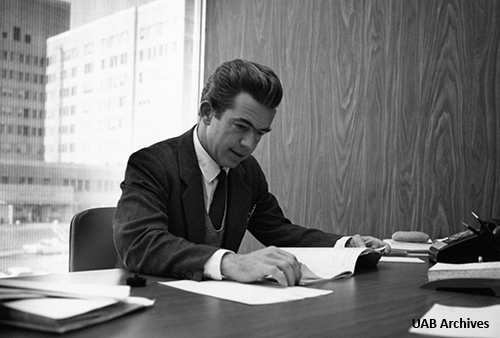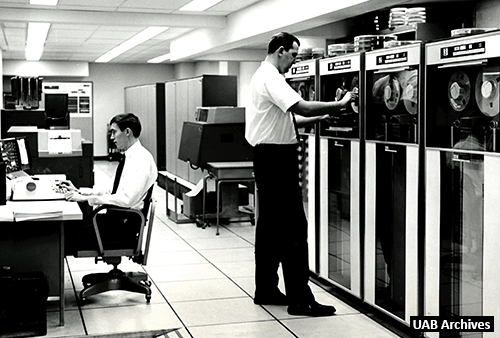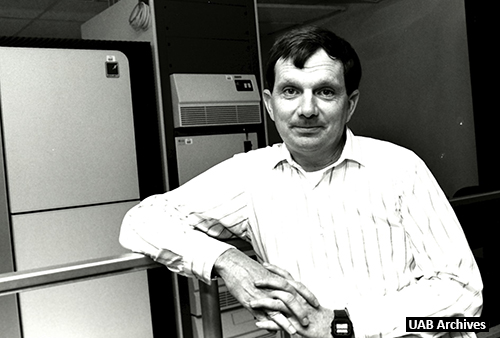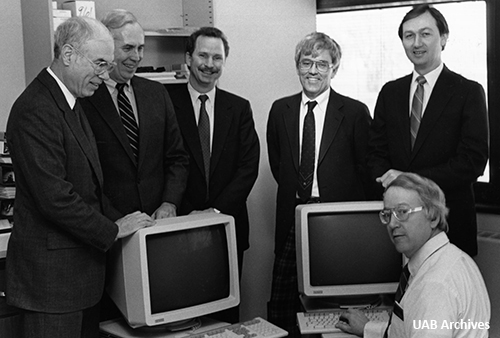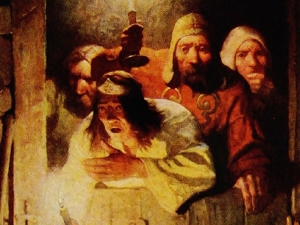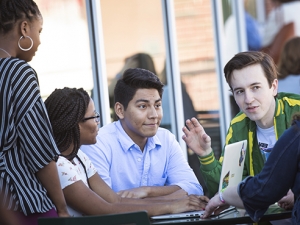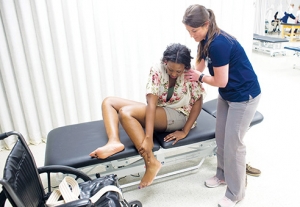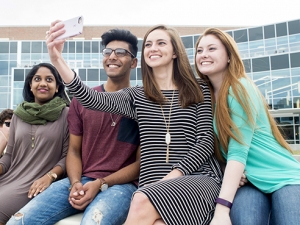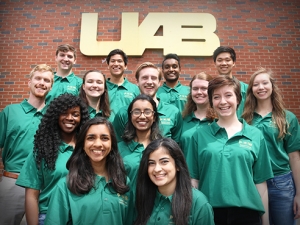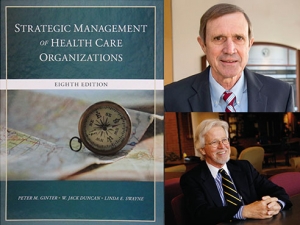 UAB's supercomputer (top) has more than seven petabytes — that's 7-quadrillion bytes — of computing storage to work with; the IBM 1401 computer (bottom) could achieve just up to to 16K 8-bit characters of core memory, about enough to hold a single, average-size Word document by today's standards.
UAB's supercomputer (top) has more than seven petabytes — that's 7-quadrillion bytes — of computing storage to work with; the IBM 1401 computer (bottom) could achieve just up to to 16K 8-bit characters of core memory, about enough to hold a single, average-size Word document by today's standards.
This month, UAB’s high-performance supercomputer installed an expansion that made it the largest supercomputer in Alabama by far — its power clocks in at 450 teraflops, a unit of computing speed equal to 1 trillion floating-point operations per second.
Fifty years ago, however, UAB’s computer roster looked a bit different. In 1967, much of its computing power was housed in the basement of the University Medical Center, where an IBM 1401 and IBM 7040 were used for payroll, patient billing and research computations — and even those machines were essentially obsolete due to the release of newer models. A few other models were located around campus, such as an IBM 1800, which was used to monitor patients and infuse medication during recovery from surgery.
As more and better computers were brought to campus, a small team developed to maintain them. That combination helped form what we now know as the Department of Computer Science. The Biophysical Sciences Division was formed in 1967, two years before UAB was designated as an autonomous university within the University of Alabama System, containing four small departments: Biostatistics, biomathematics, engineering biophysics and information sciences, the last of which was the precursor to today’s CS department. The first CS courses were offered in 1971.
In 2017, the department, which offers both bachelor’s of arts and sciences in computer science, a bachelor’s in digital forensics, and master’s, doctoral and certificate programs, has more than 390 enrolled students. Its 11 faculty have earned a reputation for cutting-edge research in a number of areas of importance, including cyber security, data science and analytics, biomedical applications and advanced cyber infrastructure.
Click through the slideshow below of photos from the UAB Archives to see a few of the people who helped get UAB’s computer science program up and running during its first several years.
-
Josiah “Jay” Macy Jr., Ph.D., a mathematician from the Einstein College of Medicine in New York, was the director of the Biophysical Sciences Division implemented in 1967 — the division was his idea —and was also a professor in information sciences.
When Macy moved to Birmingham from Einstein College, he had recently been awarded a National Institutes of Health grant to purchase a large computer system for online acquisition and processing of data from biophysical experiments. The grant came with Macy, so in 1968, the department acquired a Scientific Data Systems (SDS) Sigma 7 and Sigma 2. -
Anthony Barnard, Ph.D., joined the biomathematics department in the summer of 1968 and was on faculty when the first computer sciences courses were offered in spring 1971. Barnard’s background was in nuclear physics; the other instructors were mostly mathematicians.
“What business did this motley crew have offering courses labeled ‘computer science’?” wrote Barnard in “The First Decade of the Computer & Information Sciences Department.” “Obviously, none of us had formal qualifications in computer science… but at that time, who did? We had a lot of computing experience, were as smart as most, and confident that what we didn’t know — a lot! — we could learn.”
Barnard became chair of the information sciences department in 1972. -
When Barnard visited Birmingham in 1967, he was shown the Medical Center’s computing capability, which he wrote housed an IBM 1401 and IBM 7040.
In this photo from 1968, Larry Davis (left) and Floyd Miller (right) operated the IBM computers — in this photo, an IBM 1401 setup and IMB 729 Magnet Tape Units, used with most 7000-model IBMS — located in the basement of University Hospital. Barnard likely would have seen a scenario similar to this on his tour. -
Joe Fontana (left) was director of Computer Facilities in 1967 when Barnard toured the University Medical Center. In 1971, he was one of the first instructors of computer science courses.
Gerald A. “Gerry” Hutchison, Ph.D., (center) was a UCLA-trained mathematician, a member of the biomathematics department and another of the first computer science instructors. One of the first IS classes he taught was on information retrieval.
Emmanuel “Sandy” Mesel (right) joined UAB in 1969 to create a clinical information systems research group using the IBM S/360 Model 50s recently installed in Rust Building, the new home for the Biophysical Sciences Division that opened in 1969. -
Ed Wilson (left), a faculty member in the School of Engineering in 1971, taught a computer science course on analog and hybrid computing.
Chao-Chih Yang, Ph.D., (center) joined information Sciences in 1972; his background was in electrical engineering, and his research interests leaned more toward the theoretical end of computer science, Barnard wrote.
Roger Hanson, Ph.D., (right), dean of the School of Natural Sciences and Mathematics in 1975, approved individually designed special degree programs (SDPs) for students who wished to train for computer-related careers, because no bachelor’s degree in computer science existed at the time. -
In April 1976, IS hosted the 14th annual Southeastern Regional Conference of the Association for Computing Machinery, which Barnard calls “a landmark event for our fledgling department.” Sixty-seven papers were contributed, including one from the University of Southern Mississippi’s Robert Hyatt. Seventy-nine students traveled a total of 23,302 miles to attend the conference — and Hyatt later enrolled at UAB to study for his Ph.D.
-
Warren Jones (fourth from left) became chair of the IS department in the late 1970s, succeeding Barnard, and served in that position until 2003.
